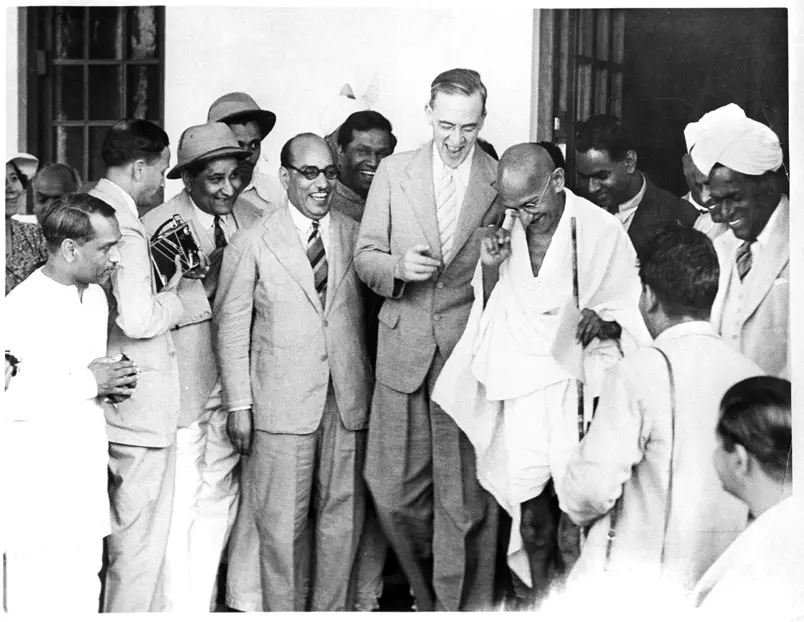The Cripps Mission: A Failed Attempt at Indian Self-Governance
History Indian HistoryPosted by NewAdmin on 2025-02-13 08:33:42 |
Share: Facebook | Twitter | Whatsapp | Linkedin Visits: 9

The Cripps Mission was a British initiative sent to India in March 1942 during World War II. Led by Sir Stafford Cripps, a senior minister in the British government, the mission aimed to gain Indian support for the war effort by promising self-governance after the war. The British government was under pressure due to the advancing Japanese forces in Asia, and they sought to secure India's cooperation to strengthen their position.
The proposal put forward by the Cripps Mission promised that India would be granted dominion status after the war, meaning it would have full self-government while still remaining within the British Commonwealth. It also offered the possibility for any province to opt out of the Indian Union if it chose to do so. Additionally, an elected body would be set up after the war to draft a new constitution, which would be implemented once it was approved by the British Parliament.
However, the mission failed to achieve its objective as it was rejected by major Indian political groups. The Indian National Congress, led by Mahatma Gandhi and Jawaharlal Nehru, was opposed to the proposal as it did not provide immediate independence and allowed for the possibility of partition. They also saw the British government's offer as an attempt to delay real political reforms. The Muslim League, under Muhammad Ali Jinnah, was also dissatisfied as the proposal did not fully recognize their demand for a separate Pakistan.
The rejection of the Cripps Mission led to increased frustration among Indian leaders, ultimately contributing to the launch of the Quit India Movement in August 1942. This movement demanded an end to British rule and intensified nationalist sentiments across the country. The failure of the mission also demonstrated the British government's reluctance to grant India real autonomy at that time.
Search
Categories
- Sports
- Business
- History
- Politics
- International
- Science & Technology
- Social Issues
- Disaster Management
- Current Affairs
- Education
- Startup Business
- Startup News
- Awards
- Community Services
- Fundraising Events
- Volunteer Services
- Health Initiatives
- Innovations and Initiatives
- In News
- dummybanners
- Awards
- Partners
- Products
- Press Releases
- News
- Fast Check
- South
- సినిమా
- Gallery
- Sunday Chronicle
- Hyderabad Chronicle
- లైఫ్ స్టైల్
- National
- క్రైం
- ట్రెండింగ్
- జాబ్స్
- అంతర్జాతీయo
- బిజినెస్
- రాజకీయం
- బిజినెస్
- సంపాదకీయం
- నవ్య
- చిత్ర జ్యోతి
- క్రీడలు
- జాతీయం
- తెలంగాణ
- తాజా వార్తలు
- మన పార్టీ
- మన నాయకత్వం
- మన విజయాలు
- డౌన్లోడ్స్
- మీడియా వనరులు
- కార్యకర్తలు
- North East Skill Center News
- Government Schemes
- Entrepreneurship Support
- Employment Opportunities
- Skill Training Programs
- Departments
- Investments
- Initiatives
- Resources
- Telangana IT Parks
- Events & Jobs
- Press Releases
- News
- Airport News
- Newtons Laws of Motion
- Karbonn in Business
- Investments in Karbonn
- Company quarterly sales
- Markets
- Auto News
- Industry
- Money
- Advertisements
- Stock target
- Company Updates
- Stock Market
- Company Sales
- Staffing and HR
- Constituency Assembly
- General News
- Srikalahasti Temple
- Bojjala Sudhir Reddy
- Technology & Innovation
- Sports
- Business
- Products
- Industries
- Services & Trainings
- Tools & Resources
- Technology Integration
- Drug Seizures & Arrests
- Telangana Narcotics
- Law & Enforcement
- Rehabilitation
- Nationwide Drug Policing
- Nigeria Seizures
- Global Operations
- Drug Awareness
- Drug Enforcement Tech
- NCB Drug Seizures
- Judicial Crackdown
- India's Surveillance Tools
- Cross-Border Links
- Women Safety
- Cyber Crimes
- Drug Abuse
- Traffic & Road Safety
- Community Connect
- Public Safety Alerts
- Citizen Assistance
- Nellore City News
- Politics & Administration
- Events & Festivals
- Agriculture & Rural
- Business & Economy
- Health & Wellness
Recent News
- Former Vice President Jagdeep Dhankhar Not Yet Requested Official Residence Retainment
- Mopping Up Operations In Lok Sabha, Speaker Om Birla Calls For Introspection
- Last-minute disruptions mark final day of parliament's monsoon session
- Market regulator SEBI plans to extend equity derivatives tenure
- Stock Picks for February: YES Securities & Sharekhan Optimistic About These 5 Companies
- Ban On Real-Money Gaming: 45 Million People Lose Rs 20,000 Crore Each Year, Says Report
- From Porn To Cricket: How Garth Stirrat Rebounds From An Unorthodox Start
- Rift In Saaniya Chandhok's Family? Grandfather Accuses Son of Forgery And Fraud